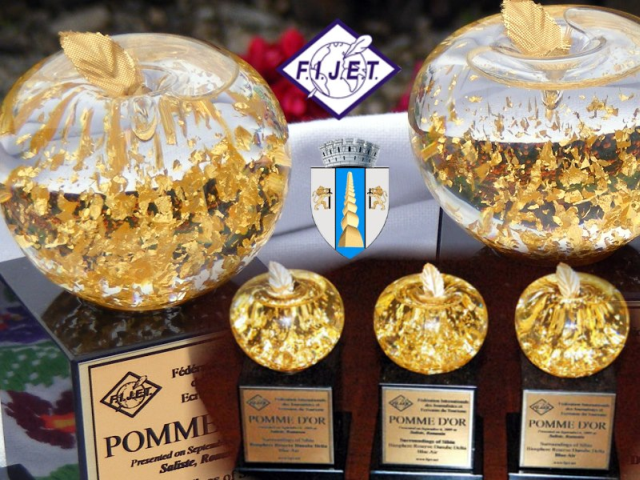Targu Jiu to Receive the Golden Apple Award
In October, the city of Targu Jiu will receive the Golden Apple Award for excellence, presented by the World Federation of Travel Journalists and Writers.

România Internațional, 10.07.2014, 11:36
The city of Targu Jiu will receive, in October, the Golden Apple award for excellence, which is presented by FIJET — the World Federation of Travel Journalists and Writers — to an organisation, country, city, or person in recognition of efforts to promote tourism. The open-air works by Brancusi displayed in the city of Targu Jiu had a decisive role in the decision made by FIJET. Marian Constantinescu, editor-in-chief with the Traveller Magazine and the president of the Travel Press Club in Romania, says the Golden Apple is seen by FIJET as the most important international award for excellence to be granted in the field of tourism:
“This award is a kind of Oscar for tourism granted by travel journalists worldwide. The Travel Press Club is the representative, in Romania, of this international organisation numbering about 600 journalists from all over the world, who work in the audio-visual field, as well as CD and film producers in the travel industry. The award is granted to a community. This time, the award goes to the tourist, administrative and economic community in Targu Jiu, for the way they promoted the open-air works of Brancusi, a project proposed by FIJET four years ago. The project was entitled The Brancusi Axis and comprises the Heroes’ Path, which boasts an artistic area unique in the world and not only in Romania and Europe: it is the only outdoor sculptural ensemble ever created by Constantin Brancusi.”
Targu-Jiu truly deserves this trophy, awarded in recognition of the special efforts deployed for the promotion of tourism. The city is a genuine open-air museum, says Ramona Ivulescu, a spokeswomen for the Targu Jiu City Hall:
“This is Constantin Brancusi’s heritage. We also have The Gate of The Kiss in Targu Jiu. Each of the supporting pillars is embossed with Barncusi’s symbol of a kiss — a circle split in two, on each face of the structure. This motif of two semicircles facing each other also serves to represent eyes looking into the gate, and, we hope, into the souls of those visiting Targu Jiu. This is one of Brancusi’s most important works. Then there is the Chair Alley, which is extremely beautiful. The chairs mark the path towards the Table of Silence, which is a reinterpretation of a traditional table. The sculptural ensemble in Targu Jiu, consisting of three large pieces, The Table of Silence, The Gate of the Kiss and the Column of the Infinite, were built as attribute to the Romanian heroes of WWI who defended the city from German troops in 1916.”
The Golden Apple award will be granted to the city of Targu Jiu in early October, and will also be marked at the FIJET international congress due at the beginning of September in Budapest. Marian Constantinescu:
“The decision to hold an award ceremony will be announced at the FIJET congress. The event will be officially announced before hundreds of journalists from all over the world and the personalities who attend the congress. This is not the first Golden Apple award to be received by Romania, but the fifth. The fist dates back to 1975 and was awarded to Bukovina. Another three awards were received in 2009. Romania is the only country to have received 3 awards in a single year. They were received for Marginimea Sibiului and its surroundings, the Danube Delta and an air company. This definitely improves Romania’s image abroad.”
The Endless Column is one of the most popular sculptures by Brancusi. It is considered a “spiritual testament” of the great artist and was defined by the renowned writer, sculptor and art critic Sidney Geist as a peak of modern art. The Endless Column stacks 16 rhomboidal modules with a half-unit at the top. Each module is 1.80 meters high and weighs 860 kilograms. The monument is also known as the Column of the Infinite. Marian Constantinescu also recommends tourists to visit the village of Hobita, Brancusi’s birthplace:
“I would recommend those interested in the life and work of Constantin Brancusi to also visit Hobita, for two important reasons. Brancusi’s house has finally been restored and turned into a museum. Vasile Brancusi, aged 50, is a relative of the artist and still lives in Hobita. He did two extraordinary things for the village: he set up a tourist tour of the village, by tractor, which also stops at Brancusi’s memorial house, and established the Constantin Brancusi International Sculpture Camp in his own yard. The first edition was held last year. I recommend this tourist destination, which is not far from Targu Jiu.”
Constantin Brancusi (1876-1957) is considered a pioneer of modern sculpture. His bronze and marble works are defined by elegant shapes and refined finish. He also made wooden sculptures of folk inspiration. Among his best-known works are Bust of a Boy, The Prayer, Sleeping Muse and Mademoiselle Pogany.






























